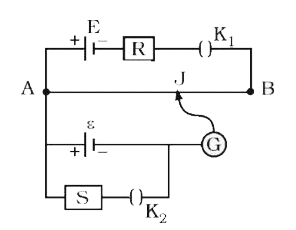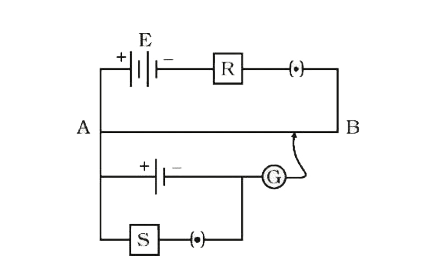A student while verifying Ohm's law calculated the value of resistance of the resistor for each set of observation .However, the values of resistance were slightly different from the actual value . Is his experiment wrong ? Justify your answer.
Step-by-Step Solution:
1. Understanding Ohm's Law: Ohm's Law states that the current (I) flowing through a conductor between two points is directly proportional to the voltage (V) across the two points, provided the temperature remains constant. The relationship is given by the formula:
V=I×R
where R is the resistance.
2. Calculating Resistance: In the experiment, the student calculates the resistance using the formula:
R=VI
where V is the voltage measured across the resistor and I is the current flowing through it.
3. Observing Variability: The student notices that the calculated resistance values are slightly different from the actual resistance of the resistor. This raises the question of whether the experiment is wrong.
4. Analyzing Possible Errors: The slight differences in the calculated resistance can be attributed to several factors:
- Resistance of Wires: The connecting wires in the circuit have their own resistance, which can affect the total current flowing through the circuit.
- Instrumental Errors: The ammeter and voltmeter used to measure current and voltage may have their own internal resistances and inaccuracies, leading to errors in the readings.
- Temperature Effects: Resistance can change with temperature, and if the experiment is not conducted under controlled conditions, this could also lead to variations.
5. Conclusion: The experiment is not wrong. The differences in the calculated resistance values are expected due to the reasons mentioned above. The student’s method of verifying Ohm’s Law is valid, and the slight discrepancies do not invalidate the experiment.
Final Answer:
The student's experiment is correct. The slight differences in the calculated resistance values compared to the actual resistance can be attributed to the resistance of the connecting wires, the internal resistance of the measuring instruments (ammeter and voltmeter), and other factors such as temperature variations.
V=I×R
where R is the resistance.
R=VI
where V is the voltage measured across the resistor and I is the current flowing through it.
- Resistance of Wires: The connecting wires in the circuit have their own resistance, which can affect the total current flowing through the circuit.
- Instrumental Errors: The ammeter and voltmeter used to measure current and voltage may have their own internal resistances and inaccuracies, leading to errors in the readings.
- Temperature Effects: Resistance can change with temperature, and if the experiment is not conducted under controlled conditions, this could also lead to variations.
The student's experiment is correct. The slight differences in the calculated resistance values compared to the actual resistance can be attributed to the resistance of the connecting wires, the internal resistance of the measuring instruments (ammeter and voltmeter), and other factors such as temperature variations.
Similar Questions
If all the resistors shown have the value 2 ohm each, the equivalent resistance over AB is
 View Solution
View SolutionSuppose you have three resistor each of value (30Ω).List all the different resistances you can obtian using them.
View SolutionTwo students ‘X’ and ‘Y’ perform an experiment on potentiometer separately using the circuit given: Keeping other parameters unchanged, how will the position of the null point be affected it
(i) X’ increases the value of resistance R in the set-up by keeping the key K1 closed and the key K2 open?
(ii) Y’ decreases the value of resistance S in the set-up, while the key K2 remain open and the key K1 closed? Justify.
 View Solution
View SolutionWhile stud dying the dependence of potential difference (V) across a resistor on the current
(I) passing through it, in order to determine the resistance of the resistor, a student took
5 readings for different values of current and plotted a graph between V and I. He got a
straight line graph passing through the origin. What does the straight line signify? Write
the method of determining resistance of the resistor using this graph.View SolutionIn the experiment of verification of Ohm's law the error in the current measurement is 1%, while that in the voltage measurement is 2%. The error in the resistance has a maximum value of
View SolutionIn the given circuit diagram, a voltmeter 'V' is connected across a lamp 'L'. How would (i) the brightness of the lamp and (ii) voltmeter reading 'V' be affected, if the value of resistance 'R' is decreased ? Justify your answer.
View SolutionTwo students X and Y perform an experiment on potentiometer separating using the circuit diagram shown here. Keeping other things unchanged
(i) X increases the value of resistance R.
(ii) Y decreases the value of resistance S in the set up. How would these changes affect the position of the null point in each case and why?
 View Solution
View SolutionA thin uniform wire AB of length 1m, an unknown resistance X and a resistance of 12Ω are connected by thick conducting strips, as shown in the figure. A battery and a galvanometer (with a sliding jockey connected to it) are also available. Connections are to be made to measure the unknown resistance X. Using the principle of Wheatstone bridge answer the following questions :
(a) Are there positive and negative terminals on the galvanometer?
(b) Copy the figure in your answer book and show the battery and the galvanometer (with jockey connect at appropriate points.
(c) After appropriate connections are made, it is found that no deflection takes place in th, from galvanometer when the sliding jockey touches the wire at a distance of 60cm from A. Obtain value of the resistance X.
 View Solution
View SolutionA thin uniform wire AB of length 1m, an unknown resistance X and a resistance of 12Ω are connected by thick conducting strips, as shown in the figure. A battery and a galvanometer (with a sliding jockey connected to it) are also available. Connections are to be made to measure the unknown resistance X. Using the principle of Wheatstone bridge answer the following questions :
(a) Are there positive and negative terminals on the galvanometer?
(b) Copy the figure in your answer book and show the battery and the galvanometer (with jockey connect at appropriate points.
(c) After appropriate connections are made, it is found that no deflection takes place in th, from galvanometer when the sliding jockey touches the wire at a distance of 60cm from A. Obtain value of the resistance X.
 View Solution
View SolutionJ.C. Slater proposed an empirical constant that represents the cumulative extent to which the other electrons of an atom shield (or screen) any particular electron from the nuclear charge. Thus, slater's screening contant σ is as : Z∗=Z−σ
Here, Z is the atomic number of the atom, and hence is equal to the actual number of protons in the atom. the parameter Z∗ is the effective nuclear charge, which according to is smaller than Z, since the electron in question is screened (shielded) from Z by an amount σ. Conversely, an electron that is well shielded from the nuclear charge Z experiences a small effective nuclear charge Z∗.
The value of σ for any one electron in a given electron configuration (i.e., in the presence of the other electrons of the atom in question) is calculated using a set of empirical rules developed by slater. according to these rules, the value of σ for the electron in question is the cumulative total provided by the various other electrons of the atom.
Q. According to Slater's rule, order of effective nuclear charge (Z∗) for last electron in case of Li, Na and K.View Solution
